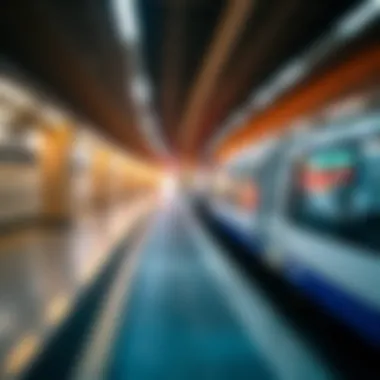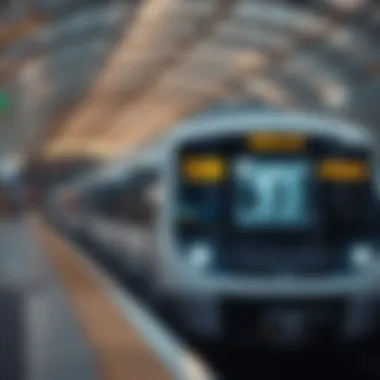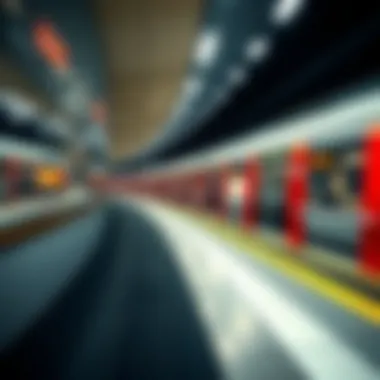Examining Dubai Metro Ticket Pricing and Insights


Intro
As the heart of the United Arab Emirates, Dubai is a bustling metropolis known for its ambitious infrastructure and modern transportation networks. Among these, the Dubai Metro stands out as a model of efficiency, connecting the city’s key areas seamlessly. However, understanding the pricing structure of Dubai Metro tickets can seem complex at first glance. This article aims to unpack the various factors that influence ticket costs, the categories available, and how this transportation system aligns with Dubai's urban planning goals.
Navigating the fare system is essential for both residents and tourists who want to make the most of their time in this vibrant city. With a variety of ticket types and fare strategies in place, it’s vital to comprehend how these elements interconnect to impact the overall commuting experience. The insights provided here will equip you with the knowledge to choose the most cost-effective options for your journeys, ensuring that you don’t overspend while traveling around Dubai’s urban landscape.
Prologue to Dubai Metro
The Dubai Metro stands as a hallmark of modern public transportation, weaving through the city’s vibrant tapestry of culture and commerce. This section will delve into the significance of the Dubai Metro, showcasing its features and determining its relevance in the broader context of urban mobility.
Overview of the Metro System
The Dubai Metro, inaugurated in 2009, is a beacon of innovation in public transit, designed to address the escalating demands of a rapidly growing urban population. Spanning over 75 kilometers, with 49 stations, the Metro connects major high-density areas, facilitating seamless movement throughout the city. The system’s two main lines—the Red Line and the Green Line—serve as arteries, allowing commuters and tourists alike to traverse the bustling streets of Dubai with relative ease.
One of the key accolades of the Dubai Metro is its state-of-the-art automated operation, minimizing human error while optimizing efficiency. Importantly, the Metro is integrated with other forms of transportation, such as buses and trams, to create a cohesive transit experience.
Importance of Public Transport in Dubai
Public transport is a critical pillar of urban infrastructure, serving not only as a means of transport but also as a catalyst for economic growth and sustainability. In a city characterized by rapid expansion and soaring population densities, such as Dubai, the presence of an effective public transport system is essential to counter traffic congestion and environmental impacts.
Utilizing the Metro can drastically reduce the number of vehicles on the road, contributing to a decrease in carbon emissions and air pollution. Furthermore, it enhances accessibility for all strata of society, promoting inclusivity and fostering a sense of community.
In addition to environmental benefits, the Dubai Metro is a linchpin for tourism. By providing easy access to landmarks like the Burj Khalifa and the Dubai Mall, it encourages visitors to explore the city more extensively, enhancing their overall experience.
"A comprehensive public transport system like the Dubai Metro is essential for a city of its scale, making it not just a necessity, but an integral part of urban life."
The pricing structure of the ticketing system reflects the balance between affordability and convenience, which is vital for attracting a diverse range of users—residents, visitors, and business travelers.
Understanding the nuances of the ticket pricing further enriches our comprehension of the public transport ecosystem in Dubai, illuminating how economic strategies and commuter needs shape this critical service.
Ticket Pricing Structure
Understanding the pricing structure of the Dubai Metro is crucial for both travelers and residents alike. Public metro systems like Dubai's are designed not only for convenience but also for economic efficiency. Each ticket you purchase reflects a well-thought-out balance between affordability and the extensive service provided, which spans the vast city. Knowing the fare categories is essential for making informed decisions, maximizing value and ensuring efficient travel routes. However, ticket pricing serves as just one part of a bigger picture encapsulating service quality, accessibility, and the overall user experience.
Standard Fare Rates
The fare rates for Dubai Metro are designed with a straightforward approach, allowing passengers to easily understand what they are paying. Depending on the distance traveled, prices can vary significantly. Generally, tickets start low, making it attractive for local commuters as well as tourists. Understanding these rates is not just a matter of budgeting—it can transform one’s travel experience in the bustling city environment.
The standard fare rates are divided into several zones, and the charges increase as you cross into additional zones. Each passenger must consider how far they intend to travel; it’s not unusual for individuals to underestimate their journeys. The ability to check rates ahead of time ensures you won’t be caught off guard at the ticket machine. This transparency plays a vital role, especially for first-time users unfamiliar with Dubai’s layout.


Types of Tickets Available
When it comes to tickets, Dubai Metro offers several types, each catering to different travel needs. These ticket options allow greater flexibility for varied commuting styles, ensuring there's something suitable for everyone—from solitary travelers to groups of tourists eager to explore the city's wonders. Here are the primary categories:
Regular Tickets
Regular tickets are the most basic type, available for one-time trips within the metro system. They can be purchased at ticket machines or employees at metro stations. The key characteristic of regular tickets is their simplicity; you pay based on the number of zones traveled, which makes budgeting your trip easy to calculate. They are a much-favored choice by those who might not use the metro every day.
A unique feature is that these tickets can be used within a limited timeframe before they expire, so they are not ideal if you plan to stay in Dubai for long. However, for someone making sporadic trips or visiting attractions, regular tickets provide a straightforward and economical option.
Daily Passes
Daily passes are designed for those who intend to use the metro multiple times in one day. Typically offering significant savings over individual tickets, they allow unlimited travel across the metro system within that 24-hour period. This kind of pass appeals primarily to tourists and locals who have a busy travel itinerary filled with activities and events.
One standout aspect of daily passes is the flexibility they provide, making them a popular choice especially during major events or festivals where numerous trips are likely. However, their distinct advantage—unlimited travel—comes at a higher upfront cost when compared to individual fares, so they might not be the best fit for infrequent riders.
Monthly Passes
For frequent travelers or daily commuters, monthly passes are a viable solution. Compared to purchasing regular tickets daily, this option yields substantial savings. Monthly passes allow unlimited access to the metro, which means users can hop on and off without constantly checking their wallets.
Key to their appeal is the convenience of having just one payment to make for the month, which suits those with set travel schedules. However, they represent a financial commitment, so if someone is just visiting for a short-term stint, it might not be the best choice.
Red Ticket vs. Gold Ticket
Understanding the difference between red and gold tickets is essential for passengers keen on comfort and convenience. Red tickets are considered standard fare, suitable for most riders sharing a common experience. Meanwhile, gold tickets cater to those who prefer a more luxurious travel option, featuring access to premium seating in designated areas of the metro.
They offer a premium experience that appeals to tourists looking for added comfort during their travels. Gold tickets also demand a higher fare, reflecting this extensive feature set. Thus, individuals must weigh their options based on budget and expected comfort during the ride.
The various ticket categories provide passengers with a tailored experience, ensuring that the diverse travel needs of Dubai’s population and visitors are met accordingly.
Navigating through the pricing structures and types of tickets available ensures that you're armed with necessary knowledge to traverse the city effectively. By evaluating your travel habits, understanding fare structures, and choosing the right ticket, you can make the most of your expense while enjoying the seamless connectivity offered by the Dubai Metro system.
Factors Affecting Ticket Prices
Understanding the ticket pricing of the Dubai Metro requires delving into a variety of factors that impact these costs. It's not just about the base fare but involves numerous external influences that can shape pricing strategies. This section sheds light on the critical elements, economical theories, and practical considerations that play a role in ticket prices, thus enriching our comprehension of the fare structure.
Government Policies and Subsidies
Government policies often serve as the backbone of public transport affordability. The Dubai government has initiated numerous programs aimed at enhancing public transport. By subsidizing ticket prices, the authorities strive to make the metro an appealing option for commuters. This not only boosts ridership but also reduces local congestion, aligns with environmental goals, and ultimately supports the economy.
For instance, consider how subsidies can lower costs for specific groups. Students and senior citizens may benefit from reduced fares set forth by regulations aimed at making transport accessible. Additionally, government regulations can affect pricing strategies based on operational costs and infrastructure investments. It's a delicate balance of maintaining affordability while ensuring the system remains sustainable.


Inflation and Economic Conditions
Economic conditions play a crucial role in determining the pricing of tickets. Inflation, which refers to the general increase in prices and the decrease in purchasing power, has a direct correlation with the costs associated with running a public transport operation. As costs for maintenance, labor, and resources rise, providers often have to raise ticket prices as a result.
Understanding this environment is vital for current and potential users. If the economy experiences a downturn, for example, the effect on discretionary spending might limit urban mobility choices. Alternatively, in a thriving economy, investment in public transport might increase, leading to better infrastructure and potentially stabilizing or even reducing costs in the long term. Thus, keeping an eye on these economic indicators is critical when planning to use the Dubai Metro.
Peak vs. Off-Peak Pricing
The question of when to travel can make a significant difference in the cost of a ticket. Peak and off-peak pricing strategies indicate a tactical approach used by the Dubai Metro to manage demand effectively. During peak hours, when the trains are packed to the brim with commuters, fare structures often reflect higher prices. This is largely a response to increased demand during these busy periods.
Conversely, traveling during off-peak hours can lead to significant savings. For those with flexible schedules, there's a financial incentive to plan trips for quieter times. Not only does this approach help to smooth out congestion during high-traffic periods, but it also rewards savvy commuters who are able to adjust their travel times accordingly. Understanding these peak times can mean the difference between a costly ride and a budget-friendly one.
Maximizing savings through smart travel scheduling can significantly enhance the cost-effectiveness of using Dubai's Metro.
Benefits of Using Dubai Metro
Navigating through Dubai can sometimes feel like hurdling through a bustling bazaar, but the Dubai Metro stands out as a beacon of efficiency and reliability in this vibrant city. Given its extensive reach and modern facilities, understanding the benefits of using the metro is paramount, especially for those who live and work here.
Cost-Effectiveness
One of the most striking advantages of using the Dubai Metro is its cost-effectiveness. Just imagine this: a journey from the Dubai Marina to Downtown Dubai costs just a fraction of what you might spend on a taxi, not to mention the savings on parking fees, which can be hefty in busy areas. The fare structure is not only transparent but also allows for different ticket options that cater to various commuting needs.
When you look closely at the monthly passes, you’ll see that they are particularly beneficial for regular commuters. The NOL Card, used within the metro, offers discounted rates for frequent travel, which makes it a smart choice for those who rely on public transport daily.
"Public transport is the lifeblood of any thriving urban environment, and Dubai has taken this seriously with its metro system."
Convenience and Accessibility
The convenience of the Dubai Metro cannot be overstated. With stations strategically located near major attractions, business districts, and residential areas, the metro enables seamless travel without the hassle of navigating through traffic jams. Furthermore, the metro operates from early morning until midnight on most days, making it an accessible option for those working late or heading out early.
Accessibility extends beyond mere timings. All stations are designed to accommodate individuals with special needs, including elevators and ramps, ensuring that everyone has access to this vital service. The ease of transferring between lines without a hitch also adds to the overall user experience.
Environmental Impact
Sustainability can’t be brushed aside, and here is where the Dubai Metro truly shines. Utilizing the metro considerably reduces the carbon footprint compared to individual car travel. In a city where the number of vehicles on the road can be staggering, the mass transit approach taken by the metro helps alleviate congestion and lowers energy consumption.
Moreover, the metro uses energy-efficient technologies and green building designs, which contribute positively to the environment. By choosing the metro, commuters are not only saving money but also participating in a larger movement towards greener urban living.
In summary, whether you're an investor eyeing opportunities or someone looking to navigate the city with ease, the benefits of using the Dubai Metro are crystal clear. From cost savings and unmatched convenience to a commitment to environmental sustainability, it's no wonder that many residents and visitors opt for this modern mode of transport.
For more information on the Dubai Metro and its operations, please visit the official Dubai Metro website.


Navigating the Metro System
Navigating the Dubai Metro System is more than just hopping on and off a train; it’s about engaging with a modern transport marvel that has transformed the commuting experience in this rapidly growing city. Understanding how to efficiently maneuver through its extensive network not only saves time but also enhances one’s overall travel experience. Whether you're a first-time visitor or a seasoned resident, mastering the ins and outs of the metro can significantly impact your daily routine and travel budget.
How to Purchase Tickets
Purchasing tickets for the Dubai Metro is a straightforward process, but knowing your options is key. Tickets can be obtained from various sources, including ticket vending machines at each metro station, where you can pay using credit or debit cards as well as cash. This is usually the quickest route. Alternatively, for those who prefer a more personal touch, you can buy your ticket directly from the station's ticket counter.
For newcomers, it’s wise to familiarize yourself with the fare zones because ticket prices vary based on the number of zones you travel through. Remember, if you’re planning on multiple rides in a day, consider picking up a daily pass which allows for unlimited travel within your designated fare zones.
"Understanding these ticket options can mean not only time saved but also significant savings in your commuting costs."
Using the NOL Card
The NOL Card simplifies travel within Dubai, serving as your gateway to the metro system, as well as buses and trams. It’s available in various types such as Silver, Gold, Blue, and Red Cards, catering to diverse travel needs.
For frequent travelers, the Silver Card is the most practical choice. It's rechargeable and provides discounts on fares, making it economical for those who rely heavily on public transport. To use the card, simply tap it at the entry and exit points of the metro stations. This not only tracks your fare but also eliminates the hassle of purchasing tickets repeatedly.
Understanding Route Maps
Familiarity with the metro route maps is an essential skill for efficient travel in Dubai. The route maps are displayed prominently at all stations and on metro trains, presenting a clear layout of the network. The metro comprises several lines, each color-coded for easy identification.
When planning your journey, you should take a moment to check the route map to ensure you understand which stations you will be traveling to and through.
- **Main Lines: **
- Red Line: Connects from Rashidiya to UAE Exchange.
- Green Line: Runs from Dubai Internet City to Al Qusais.
By understanding the layout, you can identify the most efficient transfers and connections to your destination. It's advisable to download the official Dubai Roads and Transport Authority app, which provides real-time updates and detailed maps.
Getting a handle on ticket purchasing, NOL card usage, and route navigation not only elevates your metro experience but also showcases Dubai’s commitment to a modern and interconnected urban life.
For more information regarding Dubai Metro, you can visit RTA Dubai.
By taking the time to master these aspects of the metro system, residents and visitors alike can enjoy a seamless travel experience through one of the most dynamic cities in the world.
Ending
The conclusion of this article highlights several integral aspects regarding the ticket pricing of the Dubai Metro. Understanding these pricing dynamics not only serves potential commuters—be they tourists or residents—but also investors, real estate agents, and homeowners interested in the broader implications of urban transport on property values and living conditions in Dubai.
Future of Dubai Metro
Looking ahead, the future of the Dubai Metro seems bright, evident through ongoing expansions and enhancements. There have been plans for new routes and additional stations, which will further integrate the metro system into the city’s extensive urban framework. The introduction of advanced technologies, including automation and smart fare systems, will likely streamline the commuting process. As infrastructure continues to develop, ticket prices may see adjustments to reflect both improved service and the need to maintain accessibility for all residents. Engaging in a discussion about the potential changes in ticket pricing can reveal insights into market trends and the demand for sustainable urban mobility solutions.
Final Thoughts on Ticket Pricing
In summary, ticket pricing for the Dubai Metro is not merely about numbers. It plays a pivotal role in shaping commuting habits and urban development strategies. Comprehension of these prices can influence decisions made by potential investors or individuals considering moving to areas with metro access. Ticket rates need to remain competitively priced while also reflecting the operational costs and growth ambitions of the metro system. As Dubai strives toward becoming a smart city, the pricing structure must adapt accordingly in order to remain viable. Together, these facets make understanding ticket pricing essential not just for daily commuters but also for stakeholders monitoring the socio-economic landscape of this vibrant city.







